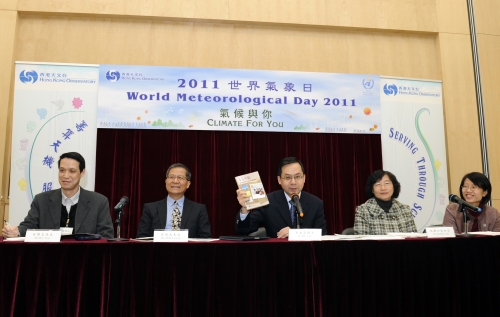|
On the occasion of World Meteorological Day today (23 March), the Director of the Hong Kong Observatory, Dr Lee Boon-ying, briefed the media on the Observatory's recent work and plans this year.
The recent severe earthquake and tsunamis in Japan attracted worldwide attention. Along with these came public concern, first on the possible local effects of the tsunami, and followed by anxiety of radiation from the damaged nuclear power plant at Fukushima. In this connection, the Observatory immediately stepped up its services to better inform the public, including the release of forecast track of air reaching Hong Kong in the next three days as well as real-time radiation data at the 10 radiation monitoring stations in Hong Kong. The Observatory has also participated in various special TV programmes on radiation monitoring, produced educational videos on the Observatory Youtube, Upper Albert Road Facebook and Roadshow and organised a public lecture on the effects of the nuclear accident on Hong Kong.
Dr Lee announced the launch of several new services on the Internet and electronic social networks today, including revamping the PDA version of the Observatory website with friendly displays and richer content, launching the Weibo website for dissemination of weather warnings and information to a wider audience, the circulation of messages about earthquakes of magnitude 6 or above through Twitter, and enhancing the ultraviolet (UV) webpage with real-time Ultraviolet-A measurements, together with advice on protection from the damaging effects of ultraviolet rays.
Reviewing the work of 2010 and looking ahead, he said that SWIRLS, a nowcasting system developed inhouse - which was used by the 2008 Beijing Olympics, the 2010 Shanghai EXPO and the Commonwealth Games in New Delhi - will be adapted to provide short-term forecasts to support the Universiade 2011 in Shenzhen later this year. Experiences gained in running SWIRLS in various setups are being channelled back for the further improvement of the system and the related services to better serve the public.
In 2010, the Observatory made significant strides in the provision of weather information on mobile devices. 'MyObservatory', which was enhanced in July last year to provide easy access to weather products specific to the user's location, has become increasingly popular, with total visitor figures exceeding 400 million since its launch in early 2010. In order to reach a broader audience, plans are underway to further develop 'MyObservatory' for use by other mobile platforms, in addition to the existing ones for iPhone, iPAD and Android mobile.
Dr Lee also talked about the findings on extreme temperature projection for Hong Kong in the 21st century. The results suggest that there would be a significant increase in hot nights and very hot days, and a significant decrease in cold days.
In respect of this year's typhoon and rain season, he said that the current La Nina event, as established in December 2010, has peaked and is expected to weaken during the spring. On the basis of past climate and the latest climate forecasts, this means that Hong Kong may start to experience tropical cyclones in June or earlier this year. For the year 2011, he expects that the number of tropical cyclones affecting Hong Kong will be normal to above normal - between 6 and 9. The annual rainfall is forecast to be near normal - between 2100 and 2700 mm. It is important that Hong Kong people prepare for the rainy and typhoon seasons to mitigate loss and damage.
To celebrate the World Meteorological Day (http://www.wmo.int/worldmetday/), the Hong Kong Observatory will be open to the public on Saturday and Sunday (26 and 27 March).
Please visit the following web page for the full text of the Director's speech at the press briefing: http://www.weather.gov.hk/dhkovoice/speech20110323e.pdf.
|
